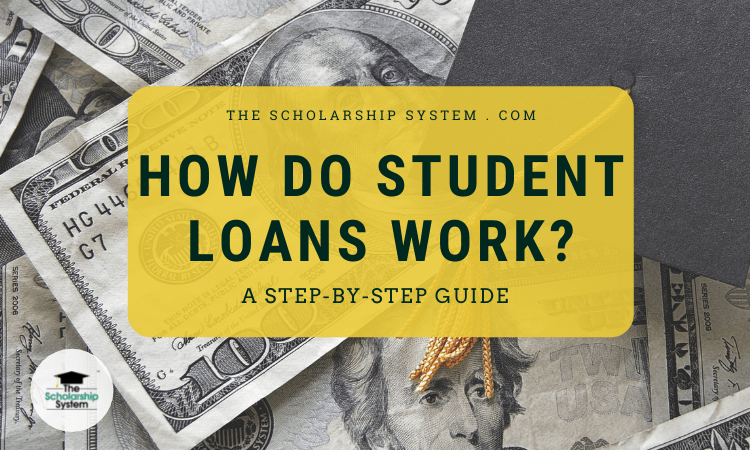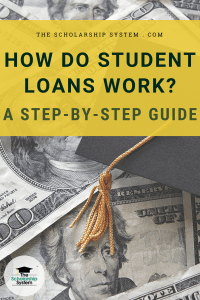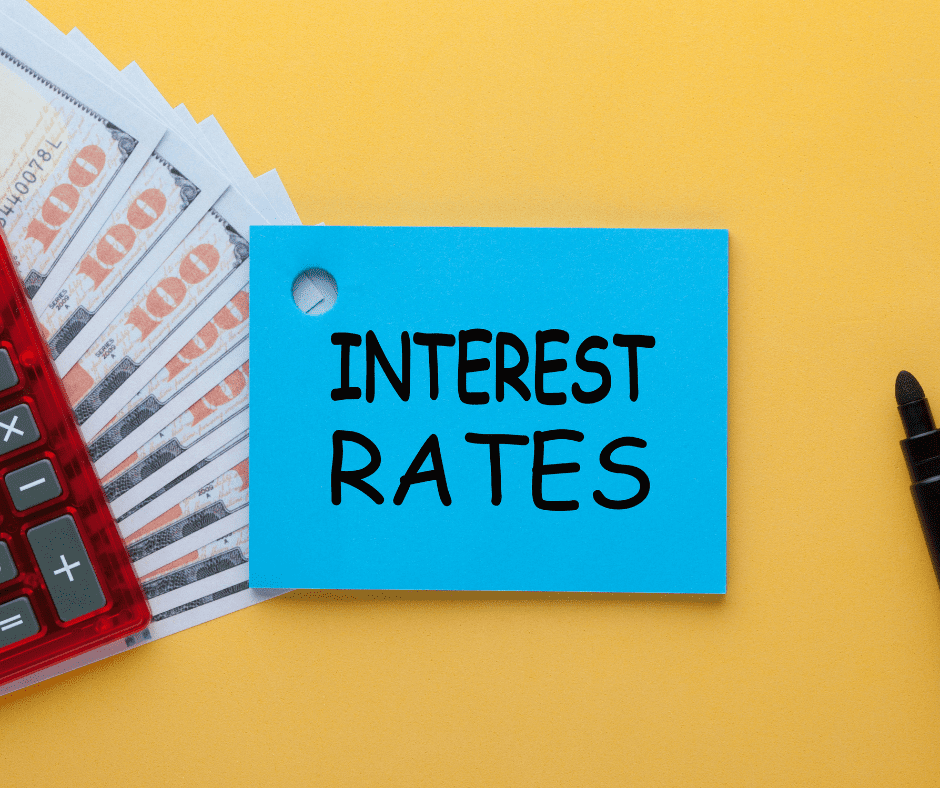Updated on June 26th, 2024
The idea of paying for college is stressful for students and their parents alike. Add to that the complexity surrounding financial aid packets and how federal student loans work, and it’s no wonder many people feel overwhelmed. To help you navigate through these mysterious waters, and provide you with some peace of mind, here is an overview designed to answer the questionhow do student loans work.
In this article, we will cover the different types of student loans and how they work, including interest rates and their impact on students’ payments. We will also explain how you can simplify your search for the best student loan options.
Contents
- 0.1 Student Loans Shouldn’t Be Your First Choice
- 0.2 What is a Student Loan?
- 0.3 What is an Interest Rate?
- 0.4 The Different Types of Student Loans
- 0.5 Great Places to Start Looking for Private Student Loans
- 1 How to Choose the Best Student Loan
Student Loans Shouldn’t Be Your First Choice
In no uncertain terms, student loans shouldn’t be your student’s first stop when it comes to the financial need of paying for college. Free money, like grants and scholarships, is always preferable to loans.
Grants are often awarded based on your student’s FAFSA and given out on a first-come, first-serve basis to those who qualify. So, make sure they have theirs finished as soon as possible for each school year, or they could miss out on these excellent opportunities.
Scholarships are different. They are awarded based on criteria set by the organization sponsoring the scholarship. Additionally, the vast majority require students to apply directly to be considered. Application requirements vary, and some options are limited to applicants with specific criteria. However, there are a lot of them out there, so your student likely qualifies for more than they realize.
The best part about scholarships is that students can apply for them all the way through high school AND college years. So if your student needs loans for the first year, they could possibly secure scholarships for the following years and reduce the amount they need.
If you would like to learn more about how your student can score scholarships, join our free webinar for parents and students. It’s a great first step towards helping them avoid student loans.
What is a Student Loan?
You can’t answer the question, “How do student loans work,” without first understanding what a student loan is.
A student loan is a lending product designed specifically for college expenses. They are often easier to obtain than other forms of financing, like personal loans, as it’s generally well-understood that incoming college students won’t have much on their credit reports.
Monies granted through a student loan are meant to handle costs like tuition, room and board, and possibly other educational requirements like books and supplies. How restrictive a loan is about how the money can be used depends on the exact type of loan involved and the rules set by the originator.
What is an Interest Rate?
Another important part of the “how do student loans work” question is understanding the interest rate.
The interest rate represents how much you will ultimately pay the lender for the ability to borrow funds. This is money owed on top of the principal. And it isn’t calculated just once. That’s why a $5,000 student loan with a 6 percent interest rate paid over 10 years won’t cost you $5,300 in total but$6,661.
To explain how this happens, we must explain compounding interest a little bit. If that makes your head spin, bear with me. I explain it a little later under “unsubsidized loans.” There is even a video to help you out!
Another point I want to make is that whenever graduates make a payment on a student loan, interest is paid first (like a mortgage.) Only the remainder is applied to the principal balance.
The Different Types of Student Loans
When you are working to understand the answer to the question “How do student loans work,” you need to understand the details about the different forms of loans available. Not all student loans are made equal. In fact, there are three primary types of student loans: federal subsidized, federal unsubsidized, and private.
Federal Student Loans
Subsidized federal student loans are a type of federal student aid, and they typically offer students the best deal. First, the interest rates are lower, saving your student money over the entire life of the loan. Second, interest isn’t assessed while your student is in school at least half-time. Third, there is a six-month interest-free grace period after they graduate. In the end, less interest means less owed.
Unsubsidized federal student loans still have favorable interest rates, but they don’t have all of the interest-free benefits of their Direct Subsidized Loans counterparts. This means interest begins accruing almost immediately once the funds are disbursed, and it will cost more to borrow money this way in the long run.
Here is a simple video showing how unsubsidized loans accumulate interest before students even graduate.
It’s a simple, homemade video (nothing fancy!), but it was one of the most straightforward in my opinion:
So, based on this video, you will see that borrowing $10,000 per year, a total of $40,000 over four years in college, ends up becoming a balance of $44,011.89.
Now, here is the kicker:
That $4,011.89 in interest is rolled into the loan balance. So when the post-graduation payments are calculated, interest is going to be based on this NEW balance of $44,011.89 versus only the $40,000. It’s as if the student ‘borrowed’ that interest and, therefore, must pay interest on it (again.) As you can see, this snowball effect (compounding interest) ends up costing students a lot of extra money. Some loans will end up almost doublethe amount borrowed by the time they are paid off.
Both subsidized federal student loans and unsubsidized federal student loans are issued by the government, and whether your student qualifies is based on their FAFSA information. The funds allowed are based specifically on your student’s tuition and annual maximums. No matter what, the loans will not exceed the tuition costs, so these funds won’t pay for extras like laptops or transportation.
The student loan interest rates associated with all federal loans, subsidized and unsubsidized, are set by the government. For undergraduate student loans disbursed between July 1, 2023, and June 30, 2024, the fixed interest rates are 5.50 percent for both kinds of loans for undergraduates. For graduate or professional students, Direct Unsubsidized Loans are set at 7.05 percent.
The government can change the interest rates for loans issued on or after July 1, 2024, but any loans disbursed prior to that won’t see their interest rates change. Essentially, once you have a federal student loan, that interest rate is locked in for the life of the loan.
Private Student Loans
Now that you have a solid understanding of the federal student loan portion of the “how do student loans work” question, it’s time to move on to private loans.
A private student loan is different. They aren’t issued by the federal government, so their terms and qualifications can vary depending on the lender. Often, it is best to view these as personal loans instead of student loans because, functionally, they are more similar to those than their federal counterparts. On a good note, the money provided might be usable for expenses beyond tuition and room and board. So, if your student needs things like a laptop, public transit passes, etc., these can help pay for those, too.
Lenders set the rules on private loans they issue, so you want to shop around if you have to go this route. It is sometimes possible to find private student loans with lower interest rates than those offered by the government, but they typically require excellent credit to qualify. For most students with a limited (if any) credit history, that isn’t going to happen alone. The lender will probably need a cosigner, and the income, credit history, and credit rating of that cosigner will have a strong impact on the rate assigned to the student loan borrowers themselves.
If your student can handle all of their expenses with grants, scholarships, and federal student loans, it is often the better way to go. However, private student loans are the next option if these still leave your student short on the money they need.
Related Articles:
Great Places to Start Looking for Private Student Loans
1.Earnest*** – Charges no origination, application, prepayment, or late payment fees. We love minimizing fees! I also personally spoke with their team and found them so helpful and responsive, which I think is a huge plus!
2.Ascent – Allows borrowers experiencing financial difficulty to enter temporary hardship forbearance for up to 24 months!
3.Sallie Mae – One of the most well-known, PLUS cosigners can be released after the borrower makes 12 consecutive on-time monthly payments. For parents who are consigning undergraduate loans, this is a major benefit.
4.Credible – Easiest to use
First and foremost, there are great resources to help you compare different student loan options. Using an online tool like Credible can simplify your search for student loans by showing you direct comparisons between different lenders. They are basically marketplaces, so you can shop around.
5.LendKey – Great comparison
One other private student loan source that came up often in my search is LendKey. They are often one of the lender options when you look into the loan comparison tools, so I thought we’d share some details on them as well.
One neat thing they mention is making small monthly student loan payments while in college. While this may sound challenging, it can be as little as $25 per month, which helps students avoid the scenario we described earlier, where interest builds up and is rolled into the principal once they graduate, thus increasing their student loan debt and payments exponentially. If a student can make these payments while in college, it would save them over $5,000 in the example we showed you. I was very impressed with Lendkey.
If you want to see what kind of offerings they have for your situation, you can fill out a quick application here: Click here to view interest rates & apply
Hopefully, with these options, you can shop around because it’s important you and your student hunt for the best deal!
More on that now…
Related Video: Best Private Student Loans of 2022
How to Choose the Best Student Loan
Determining how to select the best student loan deal is also part of answering the “how do student loans work” question.
As with any other loan, your student’s first step to finding the best option is to shop around, as I mentioned. Why? Because the lowest interest rate might not be available at your current primary bank or other previous lenders.
If undergraduate students must borrow money, we always recommend subsidized loans first since they don’t start accumulating interest until students graduate. Next would be unsubsidized from the government. Third would be private student loans. While there may be exceptions, this order typically holds true.
Order of selecting student loan options (note: there may be exceptions depending on your family’s situation):
- Subsidized loans
- Unsubsidized loans via government (Related Video:Unsubsidized Loans Are They Worth It?)
- Private student loans
So, if you’ve exhausted your options through FAFSA and the university, you can start with private student loans by using a comparison site like Simple Tuition. These can display rates from multiple private lenders, allowing you to explore your options at a glance.
Your student also needs to look beyond the interest rate when assessing options. Things like loan origination fees, grace periods, deferment options, repayment plans, and borrower rewards can all change the affordability of a loan. For example, a 4 percent origination fee can hurt just as bad as a one percent interest rate hike. This means every cost and benefit needs to be considered to determine who truly offers the best value.
Overall, the key terms and figures you will want to know before borrowing include:
- Principal amount (borrowed)
- Interest rate
- Total cost for the life of the loan (principal plus total interest)
- Monthly payments upon graduating
And don’t forget to factor in money borrowed for the second, third, and fourth (or fifth) years. You want to have a total picture for when they graduate and have to start repaying the loans.
At the bottom of this post, I put a calculator to help you see what kind of payments you are looking at.
Once the top few contenders have been identified, your student should apply to more than one lender. Since they won’t know exactly what rate they’ll be offered until they apply, there’s no better way to actually compare what option is the best without securing the offers.
Receiving the Money
Once your student secures their loans, they may be wondering how the money gets from the lender to the school. After all, it is a big part of how student loans work.
Well, in the case of federal loans, it’s pretty simple. Your student will have to identify the school they’ll be attending as part of the federal loan agreement. Then, when it comes time to pay the school, the money is sent directly to the college or university. This means your student doesn’t have to worry about coordinating that part of the payment process, as the disbursements for that year happen on their own.
Private student loans offer more flexibility, so the money can come as a check or direct deposit into your student’s bank account. While this is convenient for covering those extra expenses, like the aforementioned laptop, it can leave the burden of paying tuition on your student’s shoulders if they don’t have other funds, such as federal student loans, covering those costs. So, that’s something to consider if your student is looking at paying tuition with private loans.
When Should You and Your Child Begin?
The final part of understanding how student loans work is learning how to decide when your student should start their loan search.
If your student is destined for college in the fall, and not all of their required funds have been gathered, then now is the time for them to get started searching for the right student loans. Otherwise, they may miss out if they can’t pay tuition on time.
Begin by looking through their financial aid packet, see what can be secured there, and then determine if other options are needed. If so, it’s time to get them online to start the search.
If your student is younger than a senior, starting the hunt early in the spring of their senior year is ideal so that you have options.
What questions do you have regarding student loans? If so, post them below, and I will try to get them answered!
Think this will be helpful to your friends or family? Share the love!
FREE WEBINAR ON HOW TO SECURE THIRD-PARTY SCHOLARSHIPS FOR COLLEGE:
We always suggest exhausting all debt-free options like federal student financial aid before borrowing student loans. Did you know that it isn’t too late to apply for scholarships? Deadlines are as late as August for money for this fall. Join us on our next free webinar to learn more. https://thescholarshipsystem.com/freewebinar
FAQs
How are student loans paid off?
Repaying student loans typically involves making a monthly payment over a set period, which can vary depending on the loan type and the repayment plan chosen. When a student first borrows money, the terms of repayment are usually outlined, including the minimum monthly payment required. This payment is calculated based on the total loan amount, interest rate, and the duration of the loan.
There are various repayment options available to borrowers to help manage their student loans effectively. These options include plans based on income, which adjust the monthly payment according to the borrower’s earnings, and graduated repayment plans, where payments start lower and gradually increase over time. Selecting the right repayment plan is crucial as it can influence the total amount paid over the life of the loan.
In some cases, borrowers may qualify for loan forgiveness programs. Loan forgiveness is a process by which the borrower is no longer required to repay some or all of the loan. This is typically available to those who work in public service, education, or other qualifying professions and requires meeting specific criteria such as a certain number of years in service or a particular number of payments made. Understanding these criteria is essential for borrowers who wish to pursue loan forgiveness as an option for managing their student loans.
Are student loans paid to you or the school?
When it comes to the distribution of student loans, the process varies based on the type of loan. For federal student loans, such as Direct Unsubsidized Loans or Subsidized Loans, the funds are paid directly to the school. This payment covers tuition, fees, room and board, and other school charges. After these charges are covered, any remaining amount is given to the student to help with other educational expenses like books and supplies.
On the other hand, private student loans from banks, credit unions, or other lenders may have different disbursement procedures. Some of these lenders will also pay the funds directly to the school, ensuring that tuition and related fees are prioritized. However, depending on the lender’s policies and the specifics of the loan agreement, there can be cases where the funds are disbursed directly to the student. In those cases, it is the student’s responsibility to manage the money wisely and ensure all school-related expenses are paid on time.
How much money do student loans give you?
The amount of money a student can borrow through federal student loans is determined by specific federal student loan limits. These limits vary based on several factors, including the student’s status as a dependent or independent, their year in school, and the type of federal loan. For example, dependent undergraduate students can typically borrow less compared to independent undergraduates or graduate students, who have higher loan limits.
Federal loan limits are designed to help ensure students don’t borrow more than they might reasonably be able to repay. For undergraduates, these limits range from $5,500 to $12,500 per year, depending on their year of study and dependency status. Graduate and professional students, however, can borrow up to $20,500 annually.
There is also a cumulative limit, which caps the total amount students can borrow from the federal government throughout their academic career. This ranges from $31,000 to $57,500 for undergraduate students, though reaches as high as $138,500 for graduate or professional students.
Unlike federal student loans, private student loan limits can vary significantly. Typically, private lenders allow students to borrow up to the total cost of attendance, minus any other financial aid received. This cost includes tuition, room and board, books, travel, and other educational expenses.
The exact amount a student can borrow will depend on their credit score, the presence of a cosigner, and their or their cosigner’s income and debt ratios. Because private loans can often cover a larger portion of educational expenses, they are sometimes used when federal loans don’t fully meet the student’s financial needs. However, it’s essential for borrowers to carefully consider the terms of these loans, as interest rates may be higher and less flexible compared to federal loans, and they typically do not offer the same protections and forgiveness programs.
Is $30,000 in student loans a lot?
Whether $30,000 in student loans is considered a lot depends on several factors, including the borrower’s expected future earnings, the loan’s interest rate, and the borrower’s financial management. As a matter of context, $30,000 is close to the average student loan debt for graduates in the United States. While this figure is manageable for some, it can be burdensome for others, depending on their financial situation and career path.
The concept of discretionary income is crucial in assessing the impact of this level of debt. Discretionary income is the amount of a person’s earnings remaining after deducting taxes and essential living expenses. It is a key factor in determining monthly student loan payments, especially under income-driven repayment plans, which set payments based on a percentage of discretionary income.
Plus, the term of the loan and the associated interest rates can significantly affect the total amount paid over time. For instance, a higher interest rate can increase monthly payments and the total cost of the loan, making $30,000 in debt more challenging to manage. Additionally, the borrower’s employment stability and career growth prospects should also be considered, as these will influence the ability to consistently make payments without financial strain.
Overall, while $30,000 in student loans is a common amount for many graduates, whether it is “a lot” depends on individual financial circumstances, career trajectories, and the specific terms of the loan. Borrowers should consider these factors and possibly consult with a financial advisor to plan effectively for debt repayment.
What is a Direct Consolidation Loan?
A Direct Consolidation Loan gives borrowers a way to functionally combine multiple federal education loans into one loan, potentially simplifying the repayment process. By consolidating, a borrower might also gain access to additional loan repayment plans and forgiveness programs.
This type of loan replaces the existing federal student loans with a single loan, having one monthly payment instead of multiple payments. The interest rate for a Direct Consolidation Loan isn’t technically a brand new rate. Instead, it’s a calculated as the weighted average of the interest rates on the existing loans being consolidated, rounded up to the closest one-eighth of one percent. This means that while the consolidation might not necessarily lower the interest rate, it can make managing payments easier by having just one lender and one monthly bill.
Direct Consolidation Loans also provide access to several federal benefits, including income-driven repayment plans, which are designed to make repayments more affordable based on the borrower’s income and family size. Borrowers with Direct Consolidation Loans may also qualify for Public Service Loan Forgiveness (PSLF) if they work in public service and meet other program requirements.
However, it’s important to note that consolidating loans can extend the repayment period, which might result in paying more interest over the life of the loan. Borrowers should carefully consider how consolidation will affect their total interest payments and eligibility for borrower benefits before proceeding.
*Advertiser Disclosure*:
*THIS IS AN ADVERTISEMENT. YOU ARE NOT REQUIRED TO MAKE ANY PAYMENT OR TAKE ANY OTHER ACTION IN RESPONSE TO THIS OFFER.*
The Scholarship System receives compensation from Earnest on a per-funded loan basis.
Earnest Private Student Loans are made by One American Bank, Member FDIC. One American Bank, 515 S. Minnesota Ave, Sioux Falls, SD 57104.
Earnest loans are serviced by Earnest Operations LLC, 535 Mission St., Suite 1663 San Francisco, CA 94105, NMLS #1204917, with support From Navient Solutions, LLC (NMLS #212430). One American Bank and Earnest LLC and its subsidiaries, including Earnest Operations LLC, are not sponsored by agencies of the United States of America.
© 2022 Earnest LLC. All rights reserved.








Leave a Reply